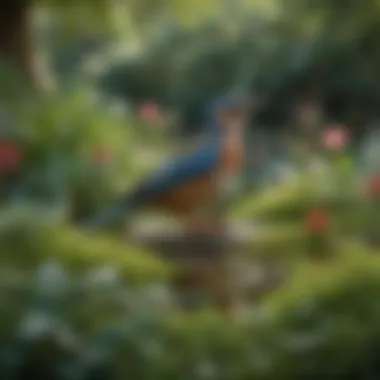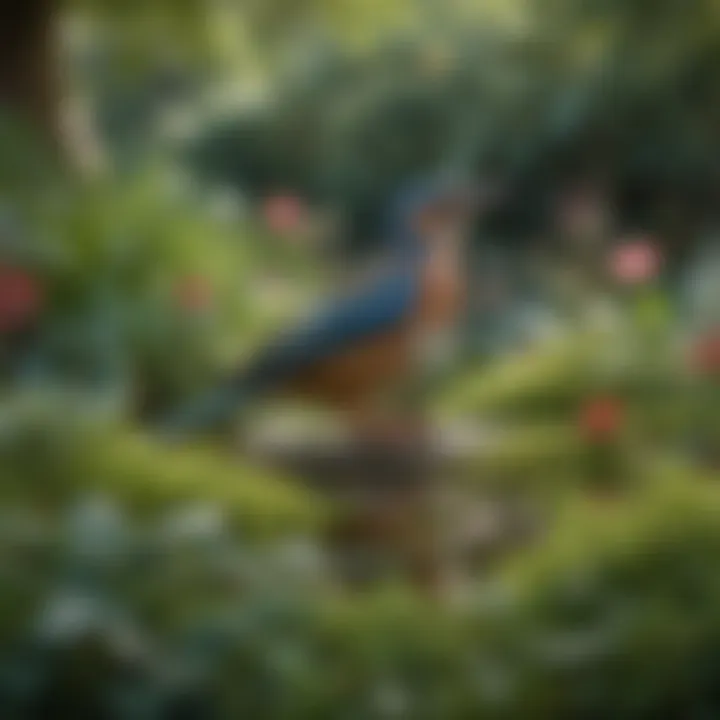Comprehensive Guide to Bird Types and Their Habitats


Intro
Birds possess an enchanting diversity that captivates many individuals across the globe. Understanding various bird types helps in not just appreciating their beauty but also in facilitating proper care, whether for pets or for conservation efforts. This guide aims to provide insight into the characteristics, habitats, and behaviors of avian species, focusing on aspects that concern both enthusiasts and pet owners. Recognizing the unique needs of different bird types lays the foundation for responsible ownership and appreciation of our feathered friends.
Understanding Your Pet
Owning a bird can be a rewarding experience, yet it comes with its own set of challenges. Understanding your pet's behavior and requirements is crucial for ensuring their well-being and happiness.
Pet Behavior Basics
Birds exhibit a wide range of behaviors that are important to their daily life. They often communicate through vocalizations, body language, and even mimicry of sounds. For instance, parrots are known for their ability to mimic human speech, while finches may engage in elaborate songs to attract mates. It's critical for owners to observe their pet's behavior to better interpret their needs and emotions.
Common Breed Characteristics
Different bird breeds have distinct characteristics that can influence their suitability as pets. Parrots, for example, are highly social and intelligent. They require engagement and mental stimulation. Budgerigars are smaller, more manageable companions that also thrive on social interaction but are often less demanding than larger species.
Species-Specific Needs
Understanding the specific needs of each bird species is essential. For example, cockatiels may enjoy whistling and playfulness, while canaries often prefer solitude and a quieter environment. Providing the right habitat, social interaction, and mental activities goes a long way in ensuring a fulfilling life for your avian companion.
"Knowing your bird's specific characteristics is the key to successful pet ownership."
Pet Care and Maintenance
The maintenance of pet birds is paramount to their overall health and happiness. Owners should be well-informed about the basic guidelines for proper care.
Feeding Guidelines
A balanced diet is essential for the health of birds. Different species have varying dietary needs. For instance, seed-based diets may work for some but can lead to nutritional deficiencies in others. Pellets are often recommended as a stable diet, complemented with fresh fruits and vegetables.
Grooming Essentials
Regular grooming is vital. This includes trimming nails and wings as needed. Birds like parakeets can also benefit from bathing. Some prefer a shallow dish of water, while others enjoy being misted lightly.
Hygiene Practices
Maintaining a clean environment is crucial. This involves regular cleaning of cages, food and water dishes, and toys. Keeping the living space free from droppings and debris not only ensures the bird's well-being but also promotes a more enjoyable experience for the owner.
Training and Development
Training your bird can lead to a deeper bond and better behavior. Understanding training techniques is an invaluable tool for any owner.
Basic Commands and Skills
Start with simple commands like step-up or come. Positive reinforcement plays a key role in effectively teaching these commands. Treats and praise should be given to create a positive learning experience.
Behavioral Training Techniques
Consistency is essential in behavioral training. Utilizing commands during daily interactions will help reinforce desired behaviors. This consistency builds trust while facilitating learning.
Addressing Common Behavior Issues
Common problems such as biting or loud vocalizations can often be managed through training and understanding. Owners should be prepared to address these behaviors early on, ensuring that they do not escalate into ongoing issues.
Health and Wellness
Just like any pet, birds require regular health considerations to thrive.
Routine Vet Check-ups
Regular veterinary visits are important for monitoring your bird's health. An avian vet can provide insights into diet, behavior, and other essential care aspects.
Vaccination Needs
Certain species may require specific vaccinations to prevent diseases. It's wise to discuss vaccination needs with your veterinarian during check-ups.
Recognizing Signs of Illness
Observing changes in behavior, appetite, or droppings is crucial, as these can be indicators of poor health. Prompt action when changes are noticed can lead to better health outcomes.
Enrichment and Activities
Providing enrichment activities greatly enhances your bird's quality of life.
Indoor vs. Outdoor Activities
While indoor habitats provide safety, supervised outdoor time can offer stimulation and fresh air. It's important to introduce birds to outdoor environments gradually.
Interactive Toys and Games
Interactive toys can stimulate mental engagement, which is vital for happiness. Puzzle feeders and foraging toys encourage birds to explore and remain active.
Socialization Opportunities
Socialization is key for many birds. Facilitating opportunities for interaction, whether with humans or other birds, fosters well-being and reduces stress.
This guide serves as a foundation for navigating the world of birds, empowering pet owners and aficionados with knowledge about avian diversity. Understanding the various aspects of bird care is a crucial step towards enriching the lives of our feathered companions.
Understanding Bird Classification
Understanding bird classification is crucial to grasp the vast diversity of avian species present in the world. The systematic categorization of birds allows for easier identification, study, and preservation of different species. This classification sheds light on evolution, habitats and behavior, making it easier to understand the ecological roles birds play in their environments.
From a practical standpoint, bird classification aids pet owners in selecting suitable companions. Different birds come with distinct needs and characteristics. By recognizing the classification system, potential owners can make informed choices tailored to their lifestyles and preferences. Additionally, the classifications support conservation efforts by identifying threatened species and their ecological significance.
Key Elements of Bird Classification:
- Taxonomy: This involves the hierarchical system used to categorize birds based on shared characteristics.
- Families and Orders: These broader classifications group birds that exhibit similar traits, making it easier to understand their behaviors and requirements.
Overall, this classification framework serves as a foundational tool for anyone interested in avian studies, whether for companionship or conservation.
Taxonomy of Birds


Taxonomy is the science of naming and classifying organisms, which in the context of birds, organizes them into a structured hierarchy. This hierarchy starts from broad categories down to specific species. The primary levels of classification include class, order, family, genus, and species.
Birds belong to the class Aves, characterized by feathers, beaks, and oviparous reproduction. Within this class, orders group birds together based on common characteristics. For instance, the order Passeriformes includes a significant number of songbirds, known for their vocal abilities and diverse behaviors.
Understanding taxonomy is essential for bird enthusiasts. It provides insights into the relationships among species. This knowledge can deepen one’s appreciation for avian diversity and highlight the significance of maintaining species integrity in ecosystems.
Bird Orders and Families
Bird orders and families represent more specific classifications within the broader taxonomy. Orders encompass multiple families that share particular features or behavioral traits. For example, Anseriformes is the order that includes ducks and swans, both known for their aquatic habitats and distinctive bill shapes.
Each family within an order can present a wide array of species, each with unique adaptations. Families can consist of diverse traits. For instance, within the Psittacidae family, you find parrots, which have strong curved beaks suited for cracking hard seeds, and lively intelligence that makes them popular as pets.
Examples of Important Bird Orders:
- Falconiformes: This order includes birds of prey like eagles and hawks, known for their hunting skills and keen eyesight.
- Columbiformes: This order is represented by pigeons and doves, which are often found in urban areas.
Understanding these classifications helps highlight the interrelatedness of different species and enhances conservation efforts by identifying how ecosystems function cohesively. Advocating for conservation of entire orders or families can effectively protect a broad range of birds and their habitats.
Common Pet Birds
The significance of understanding common pet birds cannot be understated in the context of avian diversity. These birds are popular among pet owners for their companionship and unique characteristics. By knowing more about these species, one can enrich their relationship with their feathered friends. Common pet birds often exhibit strong social behavior, which can enhance the living environment of households, providing both joy and companionship.
When considering a pet bird, it is crucial to be aware of their specific needs and care requirements. Each bird type has distinct traits, diets, and environmental preferences that play a vital role in their overall well-being.
Parakeets
Parakeets, known for their vibrant colors and playful personalities, are among the most sought-after pet birds. These small parrots can learn to talk and mimic sounds. They usually measure around 7 to 8 inches in length. A significant characteristic of parakeets is their social nature. They thrive in environments where they receive enough interaction.
Their diet primarily consists of seeds, fruits, and vegetables. Proper nutrition is essential for preventing health issues, such as feather plucking or malnutrition. Regular socialization helps maintain a happy and healthy parakeet. They require a spacious cage and an opportunity for daily exercise outside the cage. Additionally, these birds are known for their affectionate behaviors toward their owners, which makes them suitable for families.
Cockatiels
Cockatiels are another popular choice for pet owners. These birds are slightly larger than parakeets, usually about 12 to 14 inches long. They are known for their distinctive crest and ability to whistle tunes. Cockatiels are friendly and bond well with humans. They often demonstrate a joyful and playful demeanor.
Providing a varied diet that includes pellets, seeds, and fresh fruits can help keep them healthy. Regular handling and interaction are vital for developing a bond. They show behaviors such as head-bobbing and singing, which add enjoyment to the owner's experience. Caring for a cockatiel requires attention to their emotional needs; they can become lonely if left alone for extended periods, so having a companion bird is often recommended.
Lovebirds
Lovebirds are small, affectionate parrots known for their strong pair bonding. They typically grow to a length of about 5 to 7 inches. Their vivid colors make them eye-catching pets. Lovebirds are highly social and thrive when they have a companion, be it another lovebird or their human caretaker.
To ensure their well-being, a balanced diet that includes pellets, seeds, and fresh foods is crucial. They enjoy playing and require interactive toys to stimulate their minds. Lovebirds can sometimes exhibit territorial behaviors. Proper training helps mitigate such issues and fosters a harmonious living situation. Their playful nature can be a source of joy for families.
Canaries
Canaries are known for their melodious songs and come in a variety of colors. These small birds, averaging around 5 to 8 inches, are often appreciated for their singing abilities rather than their social interactions.
The diet for canaries mainly includes seeds, and it is important to enrich their nutrition with fresh greens and vegetables. They do best in a cage where they have plenty of space to move around and sing. While they can enjoy social interaction, they are generally more independent than other pet birds. This makes them suitable for those who prefer a bird that requires less direct interaction.
Finches
Finches are small birds that come in various colors and patterns. They are known for their lively behavior and cheerful songs. Most finches range from 4 to 5 inches in length. Typically, they are best kept in pairs or small groups rather than alone, as they thrive in social environments.
Their diet should consist of high-quality seeds and some fresh fruits and vegetables. Finches do not require as much attention as some other pet birds, making them suitable for busy households. They are relatively low-maintenance and do well in a spacious cage that allows for flight and activity. Their sociable nature can bring a lively atmosphere into any space.
"Understanding the specific needs of these common pet birds can enhance the bond between owner and bird while ensuring a healthy ecosystem within the home."
By learning about common pet birds, owners can make informed decisions regarding their care, ensuring a fulfilling experience for both the birds and their families.
Exotic Birds
Exotic birds play a crucial role in the broader narrative of avian diversity. Their vibrant colors, unique behaviors, and intriguing social structures captivate many bird enthusiasts and potential pet owners. Understanding exotic birds can enhance appreciation for their beauty and ecological importance. These birds often symbolize rich ecosystems and cultural significance in their native habitats.
When considering adding an exotic bird to your family, it’s essential to evaluate several factors. Their care needs, social requirements, and potential behavioral quirks must be reviewed to ensure a harmonious relationship. Many exotic birds need more than just food; they thrive in environments that stimulate their natural instincts and social behaviors. For instance, they often require ample space to fly and explore.
Let's explore some notable examples of exotic birds:
Macaws
Macaws are known for their stunning plumage and impressive intelligence. They come in various colors, such as blue, green, and yellow. Macaws are social creatures and often live in flocks, which means they are naturally inclined to seek companionship. As pets, they require strong social interaction and mental stimulation to prevent boredom and associated behavioral issues.
Considerable attention should be given to their diet. Macaws typically eat a mix of fruits, nuts, and pellets enriched with vitamins. Taking care of a Macaw means providing opportunities for play and interaction.
African Grey Parrots
African Grey Parrots are recognized for their exceptional cognitive abilities and vocal skills. Their feathers are predominantly grey with striking red tails. This species is particularly sensitive and requires a stable environment. These parrots are known for their companionship, forming strong bonds with their owners.
Dietary needs of an African Grey are quite specific. They need a mix of seeds, nuts, fruits, and vegetables. Regular social interaction is critical in preventing loneliness. Their intelligence can lead to challenges if they are left alone for long periods, often resulting in behavioral problems.
Cockatoos
Cockatoos are characterized by their crests and sociable temperaments. They come in different varieties, including the Sulphur-crested Cockatoo and the Umbrella Cockatoo. These birds are known for their affectionate nature and playful behavior. Owners must be prepared for their vocalizations, which can sometimes be quite loud.
Appropriate care includes a balanced diet and plenty of physical and mental enrichment. Engaging toys and regular interaction are vital. Cockatoos thrive when they feel connected, making them excellent companions, but they can become destructive if neglected.
Eclectus Parrots
Eclectus Parrots are unique due to their sexual dimorphism: males are bright green, while females are primarily red and purple. This species is calm and friendly, making them a popular choice among bird owners. They have a gentle disposition and require a nurturing environment to flourish.
Their diet consists mainly of fresh fruits and vegetables, which helps maintain their health. Eclectus Parrots do well in settings where they can socialize with their owners and engage with their environment. Understanding their requirements can lead to a satisfying companionship.
"Exotic birds need more than just food; they thrive in environments that stimulate their natural instincts and social behaviors."
In summary, exotic birds present both beauty and complexity. Whether you are captivated by the vibrant feathers of a macaw or the gentle disposition of an Eclectus, understanding the care and social needs of these birds is crucial. Their significance extends beyond their aesthetics, enriching homes and providing companionship. As with any pet, thorough research and consideration are imperative before welcoming an exotic bird into your life.
Birds of Prey
Birds of prey, also known as raptors, represent a crucial aspect of avian diversity that enhances our understanding of ecosystems. Their role as predators is essential in maintaining the balance within their habitats. They are characterized by strong talons, keen eyesight, and sharp beaks, which are adapted for capturing and consuming their prey. This section discusses the significance of birds of prey and delves into specific types, highlighting their unique characteristics and contributions to the environment.
Birds of prey serve as indicators of environmental health. The presence of these birds often reflects the state of local ecosystems. They can help maintain population control of smaller animals, thus ensuring that ecosystem dynamics remain balanced. When studying avian diversity, understanding the various species of raptors and their behaviors becomes imperative. This helps us appreciate not only their beauty but also their critical function in nature's order.
Moreover, these birds can invoke interest in conservation efforts. Many species of raptors are facing threats due to habitat loss, poisoning, and climate change. By educating ourselves about birds of prey, we identify the issues they face and, consequently, the need for proactive conservation strategies.


Eagles
Eagles are among the most recognized birds of prey, renowned for their majesty and prowess. They belong to the family Accipitridae and are found in various habitats, ranging from forests to deserts. The most notable characteristic of eagles is their exceptional eyesight, which allows them to spot prey from great distances.
There are numerous species of eagles, including the Bald Eagle, which is a symbol of the United States, and the Golden Eagle, famed for its hunting skills. These birds typically build large nests, called eyries, in high places like cliffs or tall trees. This positioning gives them a strategic advantage for hunting.
Eagles primarily feed on fish, birds, and small mammals. Their hunting technique varies by species but often involves soaring at high altitudes and diving at incredible speeds. By understanding eagles, we gain insight into avian hunting strategies and the ecological roles they play.
Hawks
Hawks, like eagles, are a vital component of the raptor family. They are smaller than eagles but equally fascinating in their behaviors and adaptations. Hawks belong to several genera, with Buteo and Accipiter being the most common. Their adaptability allows them to thrive in various environments, from forests to open fields.
These birds are known for their exceptional agility in the air. Depending on the species, hawks can vary significantly in size, coloration, and hunting techniques. For instance, the Red-tailed Hawk often uses its keen eyesight to locate prey from a perch before swooping down to catch it. In contrast, the Cooper's Hawk is more agile and often engages in rapid flights to chase down smaller birds.
Hawks play a vital role as controllers of rodent populations. Their presence can help maintain the balance in ecosystems where their prey is common. These hunting patterns highlight the importance of hawks as predators and their place within the food web.
Owls
Owls present a unique approach to predation, operating primarily during the night. They belong to the family Strigidae and are known for their distinctive facial discs, enabling them to hear and locate prey with remarkable accuracy. Owls have specialized feathers that allow for silent flight, making them effective nocturnal hunters.
There are many species of owls, such as the Great Horned Owl and the Barn Owl. Each species has developed its hunting style, primarily targeting small mammals, insects, and other birds. The physiology of owls gives them an edge in low-light conditions. Their combination of silent flight, keen eyesight, and acute hearing for prey detection makes them fascinating subjects for study.
Owls also symbolize wisdom in many cultures, yet they face threats from habitat destruction. By focusing on owls, we can learn the nuances of nocturnal hunting and the conservation challenges they encounter.
Understanding birds of prey helps us appreciate their ecological significance and encourages conservation efforts to protect these remarkable creatures for future generations.
Water Birds
Water birds play a significant role in maintaining the ecological balance of their environments. They inhabit various aquatic ecosystems like lakes, rivers, and ponds. Understanding water birds enhances our awareness of biodiversity and the importance of conservation efforts. Each group within this category has unique adaptations that enable them to thrive in their specific habitats. For pet enthusiasts and nature lovers, learning about these birds may inspire actions that support their preservation.
Ducks
Ducks are among the most common and recognizable water birds. They possess a diverse range of species, each with unique features. Ducks are often characterized by their broad bills, webbed feet, and distinctive quacking sounds.
In the wild, ducks have a varied diet consisting of aquatic plants, insects, and small crustaceans. This adaptability makes them vital for controlling insect populations in their habitats.
For bird-watchers, observing ducks can be a delightful experience. They frequently gather in large groups, especially during migrations, offering an impressive view. Ducks can also be kept as pets, with popular breeds including Pekin and Mallard.
Considering providing a habitat that includes water sources is essential for their well-being. For those interested in keeping ducks, ensure adequate space and clean water. Simple precautions can help prevent health issues
Swans
Swans are larger and more graceful than most water birds. Known for their long necks and elegant movements, swans have captured human fascination for centuries. These birds are often associated with beauty and are symbols of love in many cultures.
Swans are primarily herbivores, feeding mainly on aquatic plants and algae. They have strong social structures, often forming lifelong pair bonds. Their presence in a habitat indicates good environmental health. By maintaining vegetation and aquatic ecosystems, swans contribute positively to aquatic environments.
In managing swan populations, it's important to maintain the health of their habitats. Ensuring clean and pollution-free waters is vital for their survival. Observing swans can be an enriching experience for families, as these birds display both nurturing behavior and an impressive presence in any body of water.
Geese
Geese are highly social water birds known for their strong family bonds and migratory patterns. They have distinct honking calls and a robust body structure. Geese are often found in various habitats, including lakes, rivers, and marshlands.
Their diet consists of grasses, grains, and aquatic vegetation. Geese play an essential role in agriculture by grazing on crops and controlling weed populations. For those interested in wildlife conservation, promoting geese habitats can enhance agricultural sustainability.
For families, geese can be fascinating animals to observe. Their cooperative behavior during migration showcases teamwork and communication. When kept as pets, geese require ample space and a secure environment to thrive. It's important to consider their needs for social interaction and a varied diet.
Water birds are essential indicators of ecological health, representing the interconnectedness of species and their habitats.
Songbirds
Songbirds play a pivotal role in the world of avian diversity. Known scientifically as Oscine Passeriformes, they boast a complex vocal repertoire that has captivated both casual observers and avid birdwatchers. This section will shed light on the significance of songbirds, focusing on their unique characteristics, ecological importance, and the enjoyment they bring to bird enthusiasts. Additionally, consideration for potential pet owners is a crucial aspect of understanding these birds.
These birds are characterized by their ability to produce melodious sounds which serve various functions, from attracting mates to establishing territories. Their songs can offer clues about their health, vitality, and even differentiate between species. Observing and listening to songbirds can provide a profound connection to nature, making them essential for fostering appreciation for wildlife in urban and rural settings alike.
Sparrows
Sparrows are among the most familiar songbirds, with numerous species found worldwide. They are often small, brownish, and inhabit diverse environments from urban areas to rural farmlands. Sparrows are typically social creatures, often seen in flocks. This behavior enhances their survival, as they can better detect predators in groups. In terms of care, sparrows can adapt well to human presence, making them popular subjects for birdwatching.
Key characteristics of Sparrows:
- Size: Generally small, commonly about 4 to 6 inches.
- Diet: Primarily seeds, grains, and insects.
- Behavior: Highly social and often nest in colonies.
These common birds are not only easy to observe; they also contribute to the local ecosystem by controlling pest populations and aiding in seed dispersion. Potential pet owners should note that sparrows require ample space to fly and thrive, as well as a varied diet to keep them healthy.
Robins
Robins are recognized for their bright orange breasts and melodious singing, especially during the early days of spring. The American Robin, Turdus migratorius, is perhaps the most iconic species in North America. Robins are often associated with the arrival of warmer weather, making their songs a welcome sign for many.
Robins are adaptable birds and can thrive in a range of habitats from forests to urban gardens. Their diet primarily consists of insects and fruit, which can provide insight into their presence in gardens, where they help control insect populations and disperse seeds.
Interesting facts about Robins:
- They are ground foragers, often seen pulling worms from the soil.
- Their nest-building is intricate, using mud and grass to create stable structures.
For someone looking to keep a robin as a pet, it’s essential to consider their need for space and their social behavior.
Warblers
Warblers, a diverse group within the songbird family, are known for their vibrant colors and intricate songs. These birds are often found in moist forest habitats and are usually small, making them challenging to spot. They are highly migratory, traveling vast distances between breeding and wintering grounds. This migration is key to their life cycle, as they often rely on specific habitats for breeding.
Warblers play vital roles in their ecosystems, primarily as insectivores. They help maintain insect populations, which is beneficial for agriculture and gardening.
Notable characteristics of Warblers:
- Size: Small, with many species measuring around 4 to 6 inches.
- Color: Brightly colored plumage, particularly during breeding season.
- Vocalization: Each species has a distinct song, often used in mate attraction and territory defense.
In summary, understanding songbirds, including sparrows, robins, and warblers, allows both bird lovers and potential pet owners to appreciate their contributions to avian diversity. Their roles in ecosystems and their accessibility to humanity make them significant subjects in avian studies.
"Birds are a mirror that reflects what is noble in our human souls. To watch them sing and soar is to glimpse the beauty of nature's magnificent orchestra."
In the quest to choose a bird as a companion, one should carefully consider the specific needs of the chosen species, fostering both a fulfilling relationship and a healthy life for these enchanting creatures.


Tropical Birds
Tropical birds are crucial in understanding the intricate web of avian diversity. Their vivid colors, unique behaviors, and ecological roles enhance the richness of our planet’s biodiversity. Many residents of tropical regions have evolved to thrive in specific environments, making them fascinating subjects for observation. They play vital roles in ecosystems, such as pollination and seed dispersal, contributing to the health of their habitats.
In the context of avian enthusiasts, tropical birds offer considerable benefits. Many pet owners are drawn to these species because of their striking appearances and engaging personalities. However, potential owners must consider their specific care needs and environment suitability. Adopting a tropical bird often requires an understanding of their social behaviors, dietary requirements, and habitat preferences.
"Tropical Birds are not just beautiful; they are indicators of our planet's health. Protecting them is protecting entire ecosystems."
Ultimately, knowledge about these birds can foster better care and contribute to conservation efforts. By understanding their significance, we can extend our appreciation for these birds beyond aesthetics, recognizing their role as symbols of environmental stability and diversity.
Toucan
Toucans are perhaps the most recognized tropical birds, known for their distinctive beaks. These beaks, though large, are light and help the toucan reach fruits high in trees. They mostly feed on fruit, but they also eat insects and small animals. Toucans have a playful nature and social bonds with others, making them captivating to observe.
Their important role in seed dispersal contributes significantly to forest health. As they consume fruits and move through their habitat, they inadvertently plant seeds, aiding in forest regeneration. Unfortunately, toucan populations are affected by habitat loss and illegal trapping, which heightens the need for protective measures.
Hornbill
Hornbills are another remarkable group among tropical birds, known for their curved bills and nesting habits. These birds exhibit a unique breeding behavior where the female enters a tree cavity and is sealed inside by the male using mud and fruit pulp, leaving only a small opening for him to feed her during incubation. This fascinating behavior highlights their strong pair bonds and parental instincts.
Hornbills play a vital ecological role, much like toucans, primarily through seed dispersal. Their diet consists mainly of fruits, and they are known to forage for small mammals and insects. However, similar to toucans, hornbills face threats from deforestation and the illegal pet trade.
Understanding both toucans and hornbills gives insight into the complexities of tropical ecosystems. Their survival challenges underscore the importance of preserving their habitats and supporting conservation efforts.
Bird Conservation
Bird conservation plays a critical role in maintaining the health of ecosystems and safeguarding avian biodiversity. The loss of bird species can lead to unpredictable consequences in the environment, affecting various ecological interactions. Birds often serve as indicators of environmental quality. Thus, their decline can signal broader environmental issues. The consideration of bird conservation in this guide underlines not just the protection of individual species, but also the preservation of the complex relationships these species have with their habitats. Moreover, conservation efforts can foster a deeper understanding of the natural world among pet owners and animal lovers. This awareness can lead to informed choices in caring for domestic birds, thereby mitigating negative impacts on wild populations.
Threatened Species
Many birds across the globe face the threat of extinction due to habitat destruction, climate change, pollution, and illegal trade. Endangered species like the California Condor or the Spix's Macaw demonstrate the urgent necessity for protective measures. The IUCN Red List is a vital resource for tracking the status of these threatened species. It categorizes birds based on their levels of vulnerability, thus providing an informative overview of which species require immediate action.
- California Condor: Once on the brink of extinction, successful breeding programs have helped stabilize its population.
- Spix's Macaw: This species, native to Brazil, requires continual conservation efforts to prevent its complete extinction.
The survival of these birds not only preserves diversity but also supports the ecosystems they inhabit. Engaging in conservation helps bridge a connection between pet ownership and the natural world.
Conservation Efforts
Various organizations and governments are implementing strategies to conserve threatened bird species. Protected areas, such as national parks and wildlife reserves, have become crucial for safeguarding the habitats of diverse bird populations. In addition to habitat protection, breeding programs also prove essential in managing populations of endangered species.
Some key conservation efforts include:
- Habitat restoration to revive ecosystems that sustain bird populations.
- Legislative actions to protect birds from poaching and habitat loss.
- Public awareness campaigns aimed at educating communities about the importance of protecting avian species.
"Conservation isn't just about saving the birds; it's about preserving the richness of life around us."
Different types of bird conservation also entail fostering partnerships among scientists, local communities, and policymakers. These collaborations can create comprehensive strategies that address the needs of local avian populations while engaging and informing the public. Awareness and involvement can lead to greater success in conservation initiatives, forming a chain reaction that can generate impactful change.
Bird Behavior
Understanding bird behavior is fundamental in appreciating the complexities of avian life. Birds exhibit a variety of behaviors influenced by their biology, environment, and social needs. This section focuses on social structures, mating rituals, and communication methods, providing insights into the fascinating world of birds. Better knowledge of these behaviors is useful for anyone who keeps birds as pets or is simply an enthusiast.
Social Structure
Birds often live in structured social groups. These groups can vary in size, composition, and behavior. The social interactions within these groups play a significant role in survival and reproduction. For instance, species like parrots and pigeons often form strong family units, which help in raising young and protecting against predators.
Types of social structures include:
- Flocks: Some birds, like starlings, are known for their large flocks. Flocking provides safety in numbers and increases foraging efficiency.
- Pairs: Many songbirds form monogamous pairs for a breeding season or even for life, which fosters cooperation in raising offspring.
- Hierarchical groups: Some species, like chickens, exhibit social hierarchies establishing dominant and subordinate roles, which helps reduce conflict within the group.
The understanding of social structures can inform owners on how to create a suitable environment for pet birds, potentially impacting their well-being and happiness.
Mating Rituals
Mating rituals are critical for the continuation of bird species. These rituals vary greatly among different types of birds, showcasing their unique adaptations and strategies. Some birds engage in elaborate displays that serve to attract mates. These may include singing, dancing, or physical displays such as puffing up feathers.
Key aspects of mating rituals include:
- Courtship Songs: Many songbirds use vocalizations to attract females. The complexity and richness of their songs often determine their attractiveness.
- Visual Displays: Birds like peacocks display their feathers in a splendid fan to impress potential mates.
- Gift Giving: Some species, like certain types of wrens, present gifts. This behavior indicates their resourcefulness and suitability as mates.
Knowledge about mating rituals can help bird owners understand their pets’ behaviors and promote bonding within pairs.
Communication Methods
Birds have sophisticated communication methods, which are essential for survival, mating, and social interaction. These methods can be vocal or non-vocal. Vocal communication includes songs, calls, and alarm signals. Non-vocal communication may involve body language, feather displays, or even scent pheromones.
Understanding these methods can provide insights into:
- Vocalizations: Birds communicate through a range of sounds, each serving a different purpose, from warning calls to mate attraction. Some species can mimic human sounds, which can lead to deeper interactions with their owners.
- Body Language: Birds convey emotions through body language. For instance, puffed feathers can indicate distress or aggression, while preening can signal comfort and contentment.
- Collaboration: Many birds use signals to cooperate while foraging for food. This behavior highlights their intelligence and capacity for social bonds.
"Understanding bird behavior not only enhances our appreciation of these creatures but also fosters better relationships between humans and birds."
These insights recognize that bird behavior is not merely instinctive but a complex interplay of environment, biology, and interaction, enriching our comprehension of avian life.
Choosing the Right Bird
Selecting the right bird is essential for those who wish to welcome an avian companion into their lives. Birds can bring great joy, but they also require a significant commitment. Understanding what it means to choose the right bird involves considering various factors including species characteristics, your lifestyle, and long-term responsibilities. This article aims to provide a comprehensive look into how to make informed decisions when choosing a bird, ensuring that both the owner and the bird thrive in this relationship.
Considerations for Potential Owners
For potential bird owners, several key considerations should guide the decision-making process. First, it is crucial to research different bird species to understand their unique needs and characteristics. While some birds, like parakeets, may be ideal for beginners, others, such as African Grey parrots, may require more experience due to their intelligence and specific care needs.
- Time Commitment: Birds can live for many years; some species even live for decades. Before acquiring one, consider whether you can commit to a long-term relationship.
- Housing and Space: Different birds require varying amounts of space. Large birds like macaws need considerable room to fly and play, while smaller birds like canaries can thrive in slightly smaller environments.
- Noise Levels: Many birds are vocal. Consider whether you and your family are comfortable with potential noise, especially in an apartment or shared living situation.
- Dietary Needs: Birds have specific dietary requirements. Research the appropriate foods for the species you are interested in to ensure their health and well-being.
Evaluating these considerations will help in making a choice that aligns with personal circumstances and living arrangements, leading to a more harmonious coexistence.
Matching Personality and Lifestyle
Finding a bird that matches your personality and lifestyle is crucial for both the bird and the owner. Different species exhibit distinct temperaments and behaviors, so it is important to find a bird that can seamlessly integrate into your daily routine.
- Active Lifestyle: If you are active and enjoy engaging with pets, consider social species like cockatiels or lovebirds. They thrive on interaction and can enjoy being part of family activities.
- Quiet Preferences: Those who prefer a quieter environment might find budgerigars or finches to be more suitable. They tend to be less vocal than larger species, making them ideal for peaceful settings.
- Care Level: Assess how much time and effort you are willing to invest in care. Some birds require considerable social interaction and playtime, while others may be more independent.
In summary, aligning your choice of bird with your personal characteristics fosters a rewarding bond. A well-matched bird can enhance your home atmosphere and create lasting companionship.
"Bird ownership is a commitment that can enrich lives, but it requires proper consideration of species and personal lifestyle."
Choosing the right bird involves understanding the interplay between your lifestyle, preferences, and the bird's needs. Taking the time to reflect on these factors ensures a fulfilling experience for both the pet and the owner.







